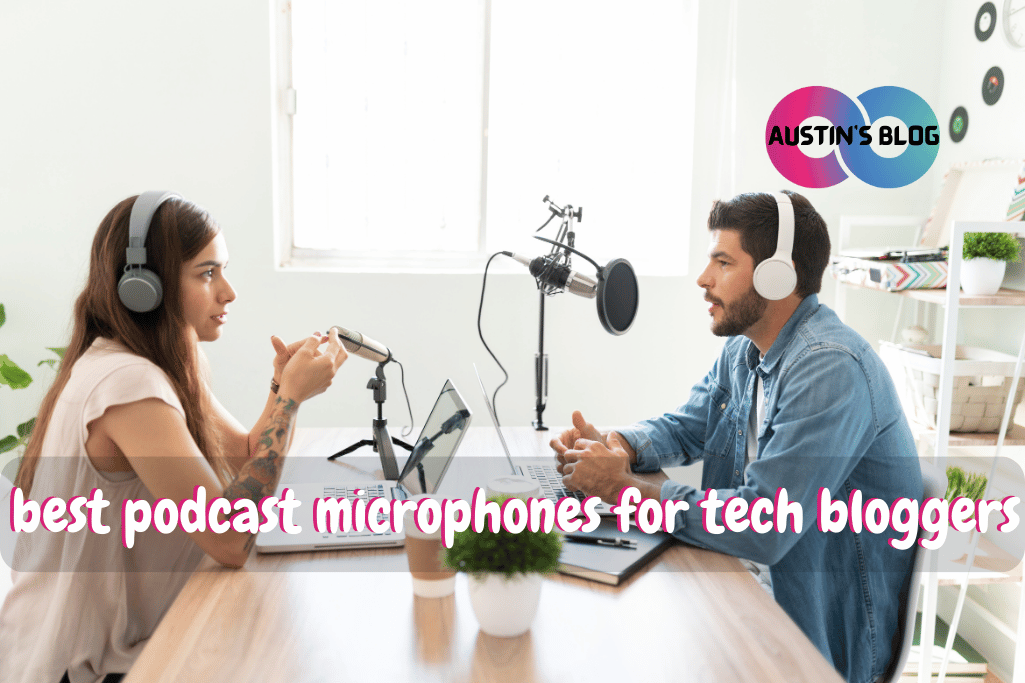Best Podcast Microphones for Tech Bloggers: From Bits to Broadcast
Introduction:
Did you know that 41% of Americans listen to podcasts monthly? [1]
That’s right, folks – we’re talking about an audience larger than the population of Canada, all ears perked for juicy tech talk.
But here’s the kicker: most tech bloggers are still recording their pearls of wisdom on mics that make them sound like they’re broadcasting from inside a tin can.
It’s like trying to explain quantum computing through a drive-thru speaker!
Picture this: you’ve just written a mind-blowing blog post about the latest AI breakthrough.
Your analysis is sharper than a silicon wafer, your insights deeper than the Mariana Trench.
But when you try to turn it into a podcast, your voice comes out sounding like a robot with a head cold.
Your groundbreaking content is being bottlenecked by subpar audio quality faster than data through a dial-up modem.
Trust me, I’ve been there. When I first started podcasting, I thought my laptop’s built-in mic would do the trick.
I was broadcasting my tech wisdom with all the audio fidelity of a 1920s gramophone.
My listeners were more focused on deciphering my words through the static than absorbing my cutting-edge insights.
But then I discovered the world of quality podcast microphones, and let me tell you, it was like upgrading from ASCII art to 4K.
Suddenly, my voice was clearer than a freshly defragged hard drive, my tech explanations smoother than a well-optimized algorithm.
My podcast went from “What did he say about blockchain?” to “Wow, I feel like he’s explaining neural networks right in my living room!”
In this guide, we’re going to explore the best podcast microphones for tech bloggers.
We’ll cover everything from budget-friendly options that’ll make your wallet smile, to premium mics that are so good, you’ll want to start every sentence with “This is NPR.” (National Public Radio)
Whether you’re a USB mic novice, an XLR enthusiast, or somewhere in between, we’ve got you covered.
So, clear your throat, do a quick “check one-two,” and let’s dive in. It’s time to transform your tech podcast from a garbled mess into an audio masterpiece that even audiophiles will appreciate. Your listeners (and your download numbers) will thank you!
USB Microphones: Plug-and-Play Perfection for Tech Talk
Alright, digital dynamos, let’s start with the Swiss Army knives of the podcast world: USB microphones.
These are the go-to choice for tech bloggers who want great audio quality without needing a degree in sound engineering.
If you’re the kind of podcaster who believes that setting up your mic should be as easy as plugging in a flash drive, this section is your audio oasis.
When I first dipped my toes into the world of USB mics, it was like discovering I had a superpower.
Suddenly, I could record high-quality audio faster than I could say “subscribe and leave a review.”
No more fumbling with phantom power or wondering what the heck XLR stands for. Just plug, play, and start dropping tech knowledge bombs.
Here are some top USB mic picks that’ll make your tech podcast sound smoother than a freshly applied screen protector:
1. Blue Yeti:
This is the Tolkien of USB mics – a true classic that’s stood the test of time. With its multiple polar patterns, it’s like having four mics in one.
I’ve used this to record everything from solo tech rants to multi-person roundtable discussions on the future of AI. It’s so versatile, it might start doing your taxes if you’re not careful.
2. Rode NT-USB Mini:
Don’t let its small size fool you – this mic packs more punch than a overclocked CPU. It’s perfect for tech bloggers on the go. I once recorded a podcast about portable tech using this mic in a hotel room, and listeners thought I was in a professional studio. Talk about meta!
3. Shure MV7:
This is like the James Bond of USB mics – sleek, professional, and versatile. It’s got both USB and XLR outputs, making it perfect for tech bloggers who might want to upgrade their setup later.
I use this for my more serious tech analysis podcasts, and it makes me sound like I should be narrating documentaries about the rise of Silicon Valley.
4. Elgato Wave:3:
Designed with streamers in mind, this mic is perfect for tech bloggers who like to get visual. Its companion software is so intuitive, it’s like having a sound engineer in your computer.
I use this for live Q&A sessions about tech topics, and the audio quality is clearer than my explanations of blockchain technology.
5. HyperX QuadCast S:
If you want a mic that sounds as good as it looks, this is your pick. With its customizable RGB lighting, it’s like having a tiny rave on your desk.
But don’t let the flashy exterior fool you – this mic captures audio cleaner than a freshly wiped SSD.
I use this for my more casual, fun tech podcasts, and listeners often compliment both the audio quality and the “cool mic” they see in my video podcasts.
Here’s a pro tip:
Invest in a pop filter and a boom arm.
The pop filter will make your plosives less explosive than a Samsung Galaxy Note 7, and the boom arm will let you position your mic perfectly without taking up valuable desk real estate.
It’s like giving your mic superpowers and invisibility at the same time.
Remember, the goal is to find a mic that makes your voice sound as good as your tech knowledge.
I learned this lesson when I recorded a whole episode on the history of processors with my mic accidentally set to the wrong polar pattern.
I sounded like I was explaining CPUs from inside a CPU.
But here’s the catch – don’t let the simplicity of USB mics make you lazy about your recording environment.
I once thought I could record anywhere with my USB mic, only to end up with a podcast that had more background noise than a Windows 95 startup sound.
Now, I always make sure my recording space is as clean as my code.
Your approach to USB mics should feel like you’re upgrading your podcast’s audio drivers.
It should lead to those “Wow, is that really my voice?” moments, not the “Why do I sound like I’m podcasting from inside a vacuum cleaner?” moments.
And most importantly, it should let you focus on sharing your tech wisdom, not fiddling with complicated audio setups.
So, embrace the simplicity, plug in that USB mic, and get ready to make your tech podcast sound more professional than a keynote at WWDC.
Because in the world of podcast microphones for tech bloggers, a good USB mic isn’t just about convenience – it’s about creating an audio experience that’s as crisp and clear as your tech insights. Let’s get recording!
XLR Microphones: Broadcast-Quality Audio for Serious Tech Talk
Alright, audio aficionados, let’s level up and talk about the crown jewels of podcast recording: XLR microphones.
These are for the tech bloggers who believe that their in-depth analysis of the latest quantum computing breakthroughs deserves nothing less than broadcast-quality audio.
If you’re the kind of podcaster who wants to sound like you’re reporting live from the cutting edge of technology, this section is your ticket to the big leagues.
When I first made the jump to XLR mics, it was like upgrading from a flip phone to a smartphone.
Suddenly, my voice had more depth than a discussion on the ethics of AI, more clarity than a 4K display, and more warmth than an overheating GPU.
It was as if my podcast had gone from standard definition to IMAX overnight.
Here are some top XLR mic picks that’ll make your tech podcast sound like it’s being broadcast from the future:
1. Shure SM7B:
This is the holy grail of podcast microphones, the mic that makes you sound like you gargle with liquid gold. It’s the choice of professional broadcasters and podcasters alike.
When I first used this to record my deep dive into the history of the internet, listeners asked if I’d hired James Earl Jones as a voice double.
2. Rode PodMic:
Don’t let its relatively affordable price fool you – this mic punches well above its weight class. It’s built like a tank and sounds like a dream. I use this for my on-the-go tech interviews, and it makes even the noisiest tech conference sound like a zen garden.
3. Electro-Voice RE20:
This is the vintage wine of microphones – classic, refined, and gets better with age. Its large diaphragm gives your voice a richness that’s perfect for explaining complex tech concepts.
When I use this, my discussions on the intricacies of machine learning algorithms sound smoother than a Tesla’s acceleration.
4. Audio-Technica AT2035:
If you want that professional sound without breaking the bank, this is your mic. It’s like the Toyota Corolla of XLR mics – reliable, high-quality, and won’t make your wallet weep.
I used this when I was starting out with XLR, and it made my podcast sound professional enough to land me interviews with tech bigwigs.
5. Heil PR-40:
This mic is like the Swiss Army knife of the XLR world – versatile, reliable, and always delivers.
Its rejection of off-axis sound is so good, you could probably record a clear podcast in the middle of a data center.
I use this for roundtable tech discussions, and it captures every nuance of our heated debates over tabs vs. spaces.
Here’s a pro tip:
Invest in a good audio interface and preamp. It’s like giving your XLR mic a secret weapon. I use the Focusrite Scarlett 2i2, and it makes my audio cleaner than a freshly formatted hard drive.
Remember, the goal is to create a professional sound that matches the quality of your content.
I learned this lesson when I upgraded to an XLR mic but kept my old, noisy preamp. The result? It was like putting racing tires on a bicycle – an improvement, but not the quantum leap I was hoping for.
But here’s the catch – don’t let the pursuit of perfect audio make you forget about content. I once spent so much time tweaking my audio setup that I neglected to properly research the topic of my podcast.
Now, I make sure my prep is as thorough as my audio setup.
Your approach to XLR mics should feel like you’re giving your podcast the red carpet treatment.
It should lead to those “I can’t believe this is my voice!” moments, not the “Why does this sound like a $1000 version of my old mic?” moments.
And most importantly, it should allow your listeners to focus on your tech wisdom, not be distracted by audio issues.
So, embrace the world of XLR, connect that professional mic, and get ready to make your tech podcast sound like it’s being broadcast from NASA’s control room.
Because in the world of podcast microphones for tech bloggers, a good XLR mic isn’t just about great audio – it’s about creating a listening experience that’s as premium as the tech you’re discussing.
Let’s make some broadcast-quality magic!
Dynamic vs. Condenser: Choosing the Right Mic for Your Tech Talk
Alright, audio architects, it’s time to demystify one of the great debates in the podcasting world: dynamic vs. condenser microphones.
This is for the tech bloggers who want to understand the science behind the sound.
If you’re the kind of podcaster who believes that choosing a mic should involve as much careful consideration as selecting the perfect CPU for a custom build, this section is your technical manual.
When I first dove into this debate, it felt like trying to choose between iOS and Android – both have their strengths, and the choice often comes down to personal preference and specific needs.
But understanding the differences made me feel like I had unlocked a secret level in the game of podcasting.
Let’s break it down:
Dynamic Microphones:
1. Durability:
These are the Nokia 3310s of the mic world – practically indestructible. Perfect for tech bloggers who record on-the-go or at chaotic tech conventions.
2. Background Noise Rejection:
They’re like noise-cancelling headphones for your voice. I use a dynamic mic (the Shure SM7B) when recording in less-than-ideal environments, like that time I podcasted from a busy maker faire.
3. No Phantom Power Required:
They’re the energy-efficient LEDs of microphones. Great for simple setups or when you’re podcasting off the grid.
4. Typically Less Sensitive:
This can be a pro or a con. It’s great for loud environments but might not capture the subtle nuances in your voice when you’re whispering about stealth startups.
Condenser Microphones:
1. Sensitivity:
These mics can pick up the sound of a pin dropping in Silicon Valley from New York. Perfect for capturing every detail of your voice as you excitedly explain the latest breakthrough in quantum computing.
2. Wide Frequency Response:
It’s like having a 4K display for your voice. I use a condenser (the Audio-Technica AT2035) for my in-depth, studio-based tech analysis podcasts where audio quality is paramount.
3. Typically Require Phantom Power:
They’re like high-performance gaming PCs – they need a bit more juice to run. This means a slightly more complex setup.
4. Can Be More Prone to Picking Up Room Noise:
Great for studio environments, not so great if your “studio” is also where your cat likes to knock things over during recordings.
Here’s a pro tip:
Consider getting one of each. I use a dynamic mic (Shure SM7B) for my weekly tech news roundup where I might have background noise, and a condenser (Audio-Technica AT2035) for my in-depth tech analysis episodes recorded in my treated home studio.
It’s like having the perfect tool for every job.
Remember, the goal is to choose a mic that complements your content and recording environment.
I learned this lesson when I tried to record a podcast about mechanical keyboards using a super-sensitive condenser mic.
Every keystroke sounded like I was podcasting in the middle of a thunderstorm.
But here’s the catch – don’t let the technical details paralyze you. I once spent so long deliberating between dynamic and condenser that I delayed starting my podcast by months.
Now, I know that great content on a decent mic trumps mediocre content on a fantastic mic any day.
Your approach to choosing between dynamic and condenser should feel like you’re selecting the perfect tool for a delicate tech repair.
It should lead to those “This is exactly what I needed!” moments, not the “I have no idea if this was the right choice” moments.
And most importantly, it should enhance your ability to share your tech knowledge, not complicate it.
So, weigh your options, consider your recording environment, and get ready to choose a mic that’ll make your tech podcast sound as professional as a WWDC keynote.
Because in the world of podcast microphones for tech bloggers, understanding the difference between dynamic and condenser isn’t just about audio quality – it’s about finding the perfect tool to amplify your tech expertise.
Let’s get technical about getting vocal!
Accessories and Setup: Optimizing Your Podcast Audio
Alright, audio optimizers, now that we’ve covered the microphones themselves, let’s talk about the supporting cast that can take your tech podcast from good to great.
Because in the world of podcasting, a great mic is like a high-end CPU – it’s crucial, but it needs the right components around it to really shine.
When I first started podcasting, I thought a good mic was all I needed. I was like a person who bought a sports car but forgot about the tires – sure, I had power, but I couldn’t really use it effectively.
But once I discovered the world of audio accessories, it was like upgrading my entire setup from a Pentium to a Core i9.
Let’s break down some essential accessories that can supercharge your podcast setup:
1. Pop Filters:
These are like ad-blockers for your audio. They filter out those pesky plosives (the popping sounds on ‘p’ and ‘b’ consonants) that can make your discussion of “big data” sound like a series of tiny explosions.
I once recorded a whole episode about “powerful processors” without a pop filter. Never again.
2. Shock Mounts:
Think of these as suspension systems for your mic. They isolate your microphone from vibrations, so when you accidentally bump your desk in excitement over the latest tech breakthrough, your audio doesn’t sound like an earthquake.
I use one for all my mics now, ever since the “Great Coffee Spill Incident of 2019” nearly ruined a recording.
3. Boom Arms:
These are like the adjustable standing desks of the audio world. They allow you to position your mic perfectly without cluttering your desk.
Plus, they make you feel like a radio DJ, which is always a bonus. I use one to keep my mic at the perfect angle, freeing up desk space for all my gadgets and gizmos.
4. Acoustic Treatments:
These are like noise-cancelling headphones for your room. Foam panels, bass traps, and diffusers can turn even the echo-iest spare room into a passable recording studio.
I added some to my home office, and suddenly my podcast stopped sounding like it was recorded in a cave.
5. Audio Interface:
For XLR mics, this is like a translation device between your microphone and your computer. A good interface can make a bigger difference to your sound than you might think.
I use a Focusrite Scarlett 2i2, and it makes my voice smoother than my pitch for why everyone should learn to code.
6. Headphones:
A good pair of studio headphones is like having X-ray vision for your audio. They let you hear exactly what you’re recording, warts and all. I use closed-back headphones to prevent sound bleed when I’m recording interviews.
Here’s a pro tip:
Create a pre-recording checklist. Mine includes checking mic levels, ensuring all accessories are in place, and doing a quick test recording. It’s like running a pre-flight check on a spacecraft – it might seem tedious, but it can save you from a world of trouble.
Remember, the goal is to create a setup that lets you focus on your content, not your equipment.
I learned this lesson when I spent an entire recording session fiddling with my new boom arm, only to realize I’d forgotten to actually press record. Now, I set up everything in advance so I can concentrate on dropping tech knowledge bombs.
But here’s the catch – don’t let accessorizing become an endless pursuit. I once fell into a rabbit hole of constantly upgrading my setup, always chasing that perfect sound. Now, I upgrade purposefully, only when it will noticeably improve my podcast quality.
Your approach to podcast accessories should feel like you’re optimizing a complex algorithm. It should lead to those “I can’t believe how much better this sounds!” moments, not the “I have no idea what half of this equipment does” moments.
And most importantly, it should enhance your ability to share your tech expertise, not complicate it.
So, set up that pop filter, position that boom arm, and get ready to create a podcast environment that’s as streamlined and effective as a well-architected software system.
Because in the world of podcast microphones for tech bloggers, great accessories aren’t just about improving sound quality – they’re about creating a seamless recording experience that lets your tech knowledge take center stage. Let’s optimize that audio!
Conclusion:
And there you have it, audio virtuosos – your all-encompassing guide to creating a top-notch podcast setup for your tech blog.
We’ve journeyed through the world of microphones, from the user-friendly USB options to the professional-grade XLR choices. We’ve demystified the dynamic vs. condenser debate and explored the accessories that can elevate your audio game to the next level.
Remember, the perfect podcast setup is like the perfect tech stack – it’s not about having the most expensive or elaborate equipment, but about having the right tools that work seamlessly together to achieve your goals.
Whether you’re recording in-depth analyses of the latest AI advancements, interviewing tech industry leaders, or breaking down complex coding concepts, your audio setup should empower you to deliver your content with clarity and professionalism.
As you continue to refine your podcasting skills, keep in mind that great audio is just one piece of the puzzle.
Your unique insights, engaging presentation style, and passion for technology are what will truly set your podcast apart.
Let your setup be the foundation that supports and enhances your content, not the star of the show.
And here’s a final piece of advice: don’t be afraid to start with what you have and upgrade gradually.
Many successful tech podcasts began with humble setups and evolved over time. The most important step is to start sharing your knowledge and building your audience.
Now, I want to hear from you! What’s your current podcasting setup? Any favorite accessories or tips you’ve discovered along the way?
Or maybe you have questions about taking your tech podcast to the next level? Drop your thoughts in the comments below. Let’s turn this into a collaborative tech podcast masterclass!
Remember, every iconic tech podcast started with someone deciding to share their passion and knowledge with the world.
With the right equipment and a lot of enthusiasm, there’s no limit to what you can achieve. Who knows? Your tech podcast might just be the next big thing in the industry.
So, gear up with your microphone of choice, optimize your recording environment, and get ready to broadcast your tech wisdom to eager listeners around the globe. Here’s to your success in the exciting world of tech podcasting.
May your audio be crisp, your content compelling, and your download numbers ever-increasing.
Happy podcasting, and may your tech talks always be music to your listeners’ ears!
Frequently Aasked Questions: Best Podcast Microphones for Tech Bloggers
Q: What are the best podcasting microphones for tech bloggers?
A: Discovering the best podcast microphones for tech bloggers involves considering factors such as sound quality, budget, and specific needs.
Popular choices include the Shure SM58 for its durability and professional sound quality, and the Rode Podcaster for its user-friendly design and excellent audio output.
Q: How do I choose a podcast microphone that suits my needs?
A: Choosing a podcast microphone involves evaluating your budget, the environment in which you’ll be recording, and the type of content you produce.
For beginners, dynamic mics like the Shure SM58 are often recommended due to their versatility and affordability. For those seeking the best upgrade, condenser microphones may offer superior sound quality.
Q: What is the best podcast mic for beginners?
A: For beginners, the Audio-Technica ATR2100x-USB is a popular choice due to its ease of use, affordability, and dual USB/XLR outputs. It provides a good balance of quality and price point, making it ideal for those new to podcasting.
Q: Are there microphones for every budget?
A: Yes, there are microphones for every budget.
From affordable options like the Samson Q2U, which offers great value for its price point, to high-end models like the Shure SM7B, which provides professional audio quality, there’s a microphone available to fit any financial plan.
Q: What makes a microphone suitable for podcasting?
A: A quality microphone for podcasting should offer clear audio capture, durability, and compatibility with your recording setup.
Features like a cardioid pickup pattern to minimize background noise and a sturdy microphone stand for stability are also important considerations.
Q: Why is mic technique important for podcasters?
A: Mic technique is crucial for podcasters as it affects the clarity and quality of the recorded audio.
Proper positioning in front of the mic, maintaining a consistent distance, and controlling plosive sounds can significantly enhance the listening experience and ensure professional sound quality.
Q: What are the benefits of using a dynamic mic for podcasting?
A: Dynamic mics are good for podcasting due to their durability, ability to handle high sound pressure levels, and reduced sensitivity to background noise.
They are often preferred in less controlled recording environments and are typically more affordable, making them a practical choice for many podcasters.
Q: How does the Rode Podcaster compare to other podcasting microphones?
A: The Rode Podcaster is a USB microphone known for its ease of use and high-quality sound output.
It is particularly favored by tech bloggers and podcasters who prioritize convenience and professional audio without the need for additional audio interfaces, making it a strong competitor among the best podcasting microphones.
Q: What should I consider when looking for the best upgrade in podcasting microphones?
A: When seeking the best upgrade in podcasting microphones, consider factors such as improved sound quality, additional features like multiple polar patterns, and enhanced build quality.
Upgrading to a microphone like the Shure SM7B can provide a noticeable improvement in audio clarity and versatility.






